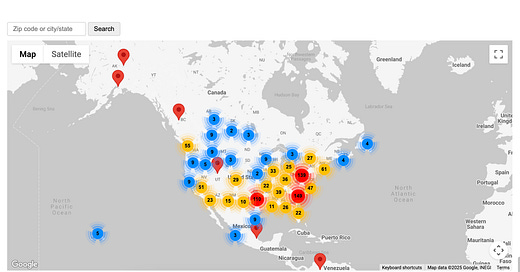The ACNA's Definitive Guide to Anglican Church Names
A Leaked Document from a Trinity Seminarian
You’re in a new city, and looking for an Anglican church to attend. You google maps it, and you’re lucky enough to find several Anglican-sounding churches within a reasonable drive. How do you know where to go? Where will you meet your small club of like minded friends?
Lucky for you, the ACNA’s liturgy task force was rumored to have formed a subcommittee to study Anglican church names in order to give priorities to the Archbishop’s council, who will then issue guidance to each diocese, which will be protested by a small group of Millennial clergy clergy from Pittsburgh and C4SO and a boomer with an axe to grind in South Carolina. The REC and Fort Worth have already prepared a counter-statement to the protesting statement, and rumour has it Todd Hunter will come out of retirement to declare the taskforce’s recommendation as actually being nonbinding on his former clergy.
Luckily, I was secretly entrusted with a draft of the findings at Trinity Anglican Seminary, had it polished by a dear friend, and am now publishing without headings or members involved, so as to circumvent the weeks of drama that would be inflicted on Archbishop Steve Wood by concerned bishops from across GAFCON.
Jackson Waters
Gospel Author (e.g., St. Luke's, St. John's): This is a mainstream neighborhood church which probably celebrates Rite I and Rite II if using the 79 prayerbook, or it uses the Renewed Ancient Text with the Anglican Standard Text during penitential seasons from the 2019. The Gospel Author church probably has a monthly kids homily and topical sermon series’.
Red Letter Day Saint (e.g., St. Mary Magdalene's, Sts. Simon and Jude): Red letter days are the major feasts of the Anglican church, and are reserved for prominent New Testament figures or Christological feasts. These churches overlap with the Gospel Author category, but will be a step more traditionalist in the direction of surpliced choirs or occasional evensongs, and stick to the lectionary.
Red Letter Day Festival (e.g., Pentecost Church, Church of the Advent): You can guarantee that these parishes will be home to utterly unhinged liturgics. Maybe it’ll be worship flags. Perhaps the rector will wear a rainbow chausible. Maybe the sermon will run north of 45 minutes. This will be a favorite choice for cradle Anglicans.
Black Letter Saint (e.g., St. Bede's, St. Patrick's): Black letter days are days named in honor of the Christians throughout history. They were common names of parishes in medieval times when the worship of saints and relics were common, and they’ve made a comeback in the “continuing” Anglican churches. If you see this name, you’re probably looking at a micro congregation of ~15-35 formed in the late 1970s.
Fictional Saint (e.g., St. Bwellensyn’s): These are rare in the United States [if necessary consult the “Black letter saint” rubric, or double check to make sure it’s not Eastern Orthodox], but if you find one in England, it’s almost certainly a highly respected 1000 year-old church built by Edward the Confessor.
Titles of Christ (e.g., Christ the Good Shepherd or Redeemer Church): We’ve all seen these churches. They’re probably a recent church plant for the good of the city, and either Vatican 2 or “Three Streams” inspired. They will use handcrafted pottery for their Eucharistic vessels, and have a granola exvangelical bake their Eucharistic bread. Missional.
Theological Category (e.g., Grace, Faith, or Covenant church): This is a suburban-to-rural congregation mostly known in the area for hosting the homeschool co-op.
Location-name or Christ Church (e.g., Northside Church or Christ Church, Benjamin Franklinville"): These are prestigious congregations found in historic neighborhoods with high end shopping and a Mercedes dealership. They were chartered by a founding father and now overseen by a female ordinary in rainbow vestments. They’re at least 200 years old, contain Tiffany stained glass or elevated pulpit, and likely have several supreme court justices on the membership roll.
Mythical Germanic Character (e.g., Gwendolyn Anglican Church, Lady-of-the-Lake Chapel): Refer to the "theological category" rubric but add a Newmanite chasuble and hanging pyx. These are especially popular with the classical school crowd.
Medieval Romanist (e.g., Saint Mary the Mediator, Christ our Purgatorial Blessing): These are rarely found in North America save in the hinterlands of Wisconsin where it is always winter but never Christmas. In England, they’re complementarian, low church Calvinists who exclusively employ Australians.
Aspirational Title or Inanimate Object (e.g., Christ for All Nations, The Table/The Way/The Cup, etc.): The pastor has never heard of vestments besides a cassock-alb and celebrates the Lord’s Supper with an acoustic guitar strapped across his chest. It’s either incredibly doctrinally sound and the most well attended, or already in the process of disaffiliating for TEC.
Sacrament Name (e.g., Blessed Sacrament, Holy Baptism, Extreme Unction Church): Homosexual rector, the vestry has probably penned a letter to the ACNA on the disreputable practice of female ordination. Mint juleps and spiked eggnog served seasonally.



